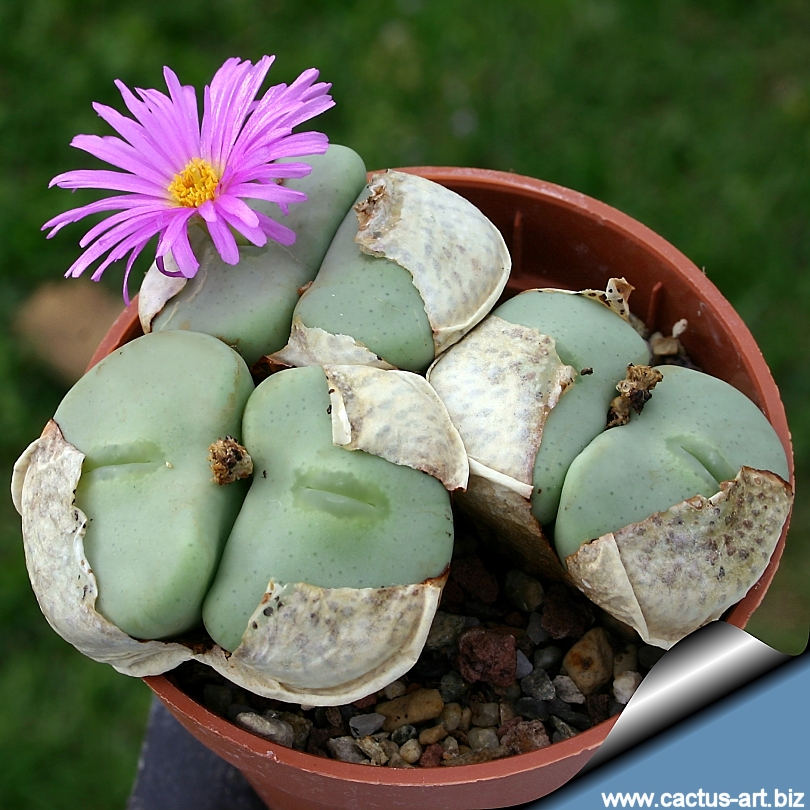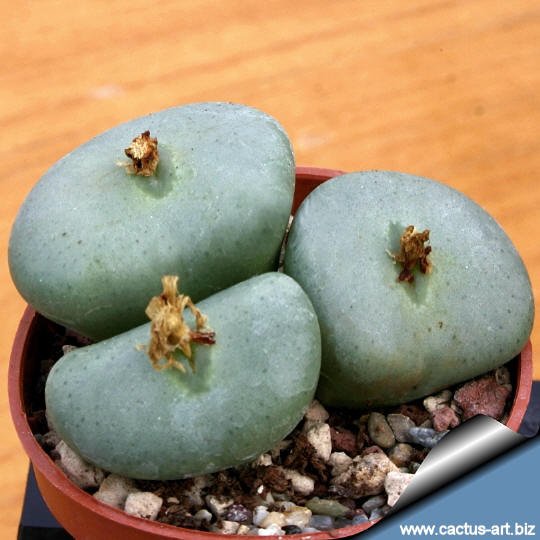|
|
|

Nice flat pale grey-green top, similar to
C. ornatum (C. flavum), but with pretty pink flowers. It grows grows
almost fattened near the soil surface.
|
|
Description: Dwarf groundcover species. Freely dividing and
variably caespitose, with single or double bodies, or forming dense mats
or cushions
Stems: Appear stemless when young but they may be stemmed with
age.
Bodies (leaves): Attractive with disc-shaped
truncate, concave or convex apices up to 2,5 cm in diameter. The
leaf pairs are completely fused obconical/triangular in shape. The
epidermis is not
bullate, roughened or pustulate, rarely papillate, usually lacking
lines. Epidermis usually dull, glaucous to pale-green or brownish green
in colour.. The fissure is faintly papillate. The sheaths are papery and
firm, sometimes friable, sheaths may be spotted or unspotted.
Flowers: Daisy-like,
scentless, early diurnal with a long tube.
Exhibit varying colours of orchid
fuchsia on long lacy lazy petals, they are very showy:
The style is
usually long while the stigmas are short.
Blooming season: August-
October, flowers are long lasting.
Fruit: The capsules are small, flat and slightly aromatic.
Cotyledons: Obconical and truncate, this species has a short
juvenile phase.


|
|
Advertising
|
|
|
|
|
Family: Mesebrianthemaceae (Aizoaceae)
Scientific name: Conophytum
wettsteinii (A. Berger) N.E. Br.
Conophytum wettsteinii is the type species
of the the WETTSTEINIA group
Origin: South Africa (Northern Cape Province,
Namaqualand)
Habitat: Grows
almost hidden in the soil on quartzite ridges
in cracks, often mixed with
Crassula elegans.
Synonyms:
-
Mesembryanthemum wettsteinii
-
Conophytum circumpunctatum
Schick & Tischer
-
Conophytum brevipes
L.Bolus
|
|
|
|

Cultivation: C. wettsteinii is
easy to grow. These plants grow on winter rain and head for summer
dormancy. More or less dormant in summer. The plant requires little
water; otherwise its epidermis breaks (resulting in unsightly scars).
Water throughout the year although minimally in summer, (only when the
plant starts shrivelling), but it will generally grow even in summer if
given water. Water regularly in winter after the previous year's leaves
have dried up. Requires good drainage. Keep cool and shaded from hot
sun in mid-summer; it needs full sun or light shade in the other
seasons. Hardy to -2°C. Ensure a very good ventilation. Avoid to repot
frequently. This plant may stay in the same pot for many years. Plants
grown in larger containers have frequently relatively poor flowers. It
might improve when the plants are given their own, small individual
pots.
Propagation: It can be
reproduced both by cuttings and seeds. Take the cutting from a grown-up
mother plant. Each
cutting must contain one or more heads, along with
a fraction of root.
|
|